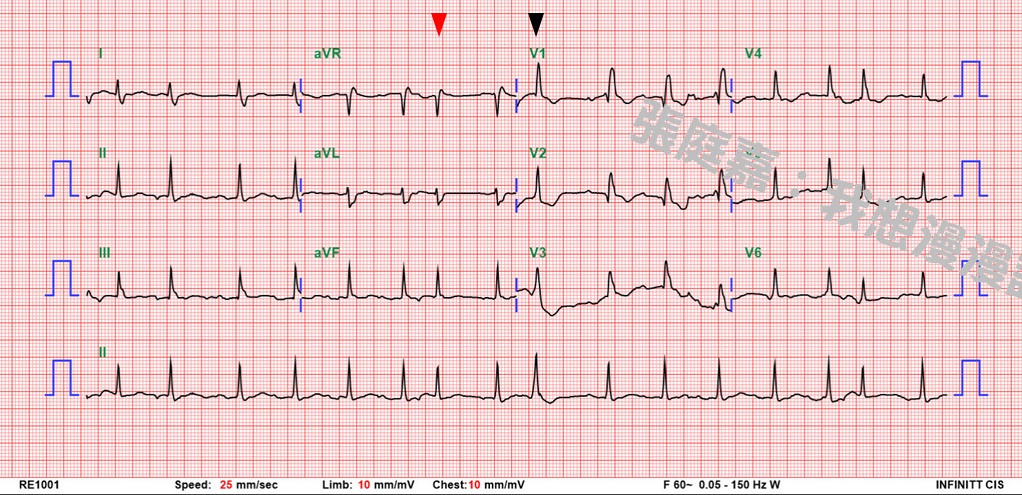氣流容積關係圖 (flow-volume loops)
流量-容積曲線紀錄在吸飽氣和用力吐氣下(Y軸)氣流的容積(X軸),根據其曲線的輪廓可以協助診斷氣道阻塞 (airway obstruction)和判斷其阻塞位置。[2]
雖然流量-容積曲線在限制型肺病也會有其特殊形狀,但並非其診斷上所必須的檢查。
正常的曲線在吐氣時,會迅速產生一個peak然後直直下滑,吸氣則剛好相反,是呈現一個對稱的紡錘狀。(如下圖一A/下方是吸氣期上方是吐氣期)
以肺容積中點畫一條切線來看,與下方、上方的交點分別是FIF50及FEF50,可發現FEF50略小於FIF50,所以正常FEF50/FIF50 < 1 (接近1)。
內專筆試時,如果對圖形不熟悉,熊熊就會看到「熊」。
作者:張庭嘉
上呼吸道 (upper airway)又細分為intra- 和 extra- thoracic,切點胸廓出口 (thoracic inlet)在suprasternal notch以上1-3公分 (約T1高度)。
但其缺點是敏感度 (sensitivity)低,尤其是在阻塞程度輕微時;另外,也可能因為同時有其他阻塞問題造成判讀困難。
上呼吸道阻塞時,必須造成氣管阻塞程度超過八成 (管腔小於8mm),才會呈現出異常的曲線圖形。
其中,最常見的吸氣曲線異常原因就是病人沒有吸飽氣或缺乏適當指導 (submaximal patient performance)。[4]
Variable extrathoracic UAO最常見原因為vocal cord paralysis,吸氣期本來就狹窄的呼吸道塌陷,吐氣期不受影響,因此 FEF50/FIF50 會非常高 (通常超過2)。(圖一B)
Variable intrathoracic UAO則是大大減低吐氣的氣流,不影響吸氣,原因是吐氣時肋膜腔壓 (intraplueral pressure)變得很「正」,導致intrathoracic airways被壓迫的關係,所以圖形在吐氣期會有一個扁平的高原,FEF50/FIF50會很低 (~0.3)。(圖一C)
(吸氣期,肋膜腔壓會很「負」,反而阻塞會減少)
Fixed UAO則是吸氣、吐氣都被影響,FEF50/FIF50會接近1 (平均0.9)。
雖然流量-容積曲線在限制型肺病也會有其特殊形狀,但並非其診斷上所必須的檢查。
正常的曲線在吐氣時,會迅速產生一個peak然後直直下滑,吸氣則剛好相反,是呈現一個對稱的紡錘狀。(如下圖一A/下方是吸氣期上方是吐氣期)
以肺容積中點畫一條切線來看,與下方、上方的交點分別是FIF50及FEF50,可發現FEF50略小於FIF50,所以正常FEF50/FIF50 < 1 (接近1)。
內專筆試時,如果對圖形不熟悉,熊熊就會看到「熊」。
作者:張庭嘉
流量-容積曲線簡介
1969年,由Miller和Hyatt兩人用來初次描述三種不同的曲線圖形:variable extra-thoracic obstruction、variable intra-thoracic obstruction、fixed obstruction (如下圖一B-D)。[3]上呼吸道 (upper airway)又細分為intra- 和 extra- thoracic,切點胸廓出口 (thoracic inlet)在suprasternal notch以上1-3公分 (約T1高度)。
但其缺點是敏感度 (sensitivity)低,尤其是在阻塞程度輕微時;另外,也可能因為同時有其他阻塞問題造成判讀困難。
上呼吸道阻塞時,必須造成氣管阻塞程度超過八成 (管腔小於8mm),才會呈現出異常的曲線圖形。
其中,最常見的吸氣曲線異常原因就是病人沒有吸飽氣或缺乏適當指導 (submaximal patient performance)。[4]
各種情境下圖形
 |
| 氣流容積關係圖 圖一 |
Variable extrathoracic UAO最常見原因為vocal cord paralysis,吸氣期本來就狹窄的呼吸道塌陷,吐氣期不受影響,因此 FEF50/FIF50 會非常高 (通常超過2)。(圖一B)
Variable intrathoracic UAO則是大大減低吐氣的氣流,不影響吸氣,原因是吐氣時肋膜腔壓 (intraplueral pressure)變得很「正」,導致intrathoracic airways被壓迫的關係,所以圖形在吐氣期會有一個扁平的高原,FEF50/FIF50會很低 (~0.3)。(圖一C)
(吸氣期,肋膜腔壓會很「負」,反而阻塞會減少)
Fixed UAO則是吸氣、吐氣都被影響,FEF50/FIF50會接近1 (平均0.9)。
為了考試記憶的話,就把那奇怪的形狀想成箭頭罷~
指向吸氣期的就是intrathoracic UAO、指向吐氣期者就是extrathoracic UAO。
常見的鑑別診斷整理如下:
另外,Unilateral mainstem bronchial obstruction單側完全阻塞的話,僅損失阻塞一半的肺功能,圖形輪廓不變,但整體面積變小。(圖二F)
反之,吐氣期有阻塞音 (wheezing),則代表其「吐氣」困難,阻塞在thoracic inlet遠端,位於trachea、bronchi、peripheral airways。
當吐氣時,胸廓內氣道外的壓力較高,將空氣往外「壓」;胸廓外,氣道內的壓力反而高過外面,造成氣道擴張。
吸氣時,顛倒過來,胸廓外的氣道會因此狹窄,胸廓內的氣道會擴張。(圖三)
用力吸、吐氣,會加重這樣的效果。
呼吸道阻塞的病灶位置在intrathoracic的話,吐氣期會讓胸廓內的氣道更狹窄,氣流通過發出高頻的連續音,一般稱wheezing。
病灶位在extrathoracic的話,吸氣才會加重其胸廓外的呼吸道阻塞,氣流通過發出低頻的連續音,甚至不用聽診器可聽見,稱之stridor。
2. Aboussouan LS, Stoller JK. Diagnosis and management of upper airway obstruction. Clin Chest Med 1994; 15:35.
3. Miller RD, Hyatt RE. Obstructing lesions of the larynx and trachea: clinical and physiologic characteristics. Mayo Clin Proc 1969; 44:145.
4. Morris MJ, Christopher KL. The flow-volume loop in inducible laryngeal obstruction: one component of the complete evaluation. Prim Care Respir J 2013; 22:267.
A. 聲帶麻痺(vocal cord paralysis),造成呼吸道阻塞(variable extra-thoracic obstruction)。
B. 復發性多軟骨炎(relapsing polychondritis),造成呼吸道阻塞(variable intra-thoracic obstruction)。
C. 慢性阻塞性肺病(chronic obstructive pulmonary disease, COPD)造成的阻塞性通氣障礙(obstructive ventilatory impairment)。
D. 肺纖維化(pulmonary fibrosis)造成的侷限性通氣障礙(restrictive ventilatory impairment)。
E. 以上皆正確
2. 流量-容積曲線(flow-volume loop)如圖所示,此人的肺功能診斷最可能為:
(A)阻塞性異常
(B)侷限性異常
(C)混合性異常
(D)正常老年人
3. 某病患使用呼吸器之 flow-volume 曲線如圖,由 A 到 B 最有可能為下列何種情況?
(A)用力吐氣
(B)肺順應性(compliance)降低
(C)吸入支氣管擴張劑
(D)支氣管收縮
4. 某病患使用呼吸器之 flow-volume 及 pressure-volume 曲線如圖,最有可能為何種情況?
(A)用力吐氣
(B)管路漏氣
(C)用力吸氣
(D)吐氣時間過長
5. 有一 COPD 病人使用 SIMV mode 時提高強制性的呼吸次數來代償呼吸性酸中毒,接下來發現病人呈現窘迫情況,血壓由 135/95 變成 125/85 mm Hg,其 flow-volume圖變化如右。下列處置何者最為適當?
(A)降低吸氣流速
(B)增加潮氣容積(tidal volume)設定
(C)改成 assist-control(A/C)mode
(D)以上皆非
6. Spirometry 檢查結果,Flow-volume curve 與 Volume-time curve 之比較何者錯誤?
(A)Flow-volume curve 較易看出阻塞型障礙
(B)Flow-volume curve 較易讀出 FEV1 值
(C)Flow-volume curve 較易看出有上呼吸道阻塞
(D)Flow-volume curve 較易看出吐氣過程配合度是否良好
- Variable intrathoracic obstruction: tracheomalacia of the intrathoracic airway, bronchogenic cysts, tracheal lesions (often malignant)
- Variable extrathoracic obstruction: vocal fold paralysis, extrathoracic tracheomalacia, polychondritis, mobile tumors
- Fixed upper airway obstruction: tracheal stenosis, foreign body, nasopharyngeal carcinoma
 |
| 氣流容積關係圖 圖二 |
另外,Unilateral mainstem bronchial obstruction單側完全阻塞的話,僅損失阻塞一半的肺功能,圖形輪廓不變,但整體面積變小。(圖二F)
機轉說明
以上呼吸道阻塞來說,聽診分辨,如吸氣期有阻塞音 (stridor),代表其「吸入」困難,阻塞在thoracic inlet近端,可能在鼻子、pharynx或larynx;反之,吐氣期有阻塞音 (wheezing),則代表其「吐氣」困難,阻塞在thoracic inlet遠端,位於trachea、bronchi、peripheral airways。
當吐氣時,胸廓內氣道外的壓力較高,將空氣往外「壓」;胸廓外,氣道內的壓力反而高過外面,造成氣道擴張。
吸氣時,顛倒過來,胸廓外的氣道會因此狹窄,胸廓內的氣道會擴張。(圖三)
用力吸、吐氣,會加重這樣的效果。
呼吸道阻塞的病灶位置在intrathoracic的話,吐氣期會讓胸廓內的氣道更狹窄,氣流通過發出高頻的連續音,一般稱wheezing。
病灶位在extrathoracic的話,吸氣才會加重其胸廓外的呼吸道阻塞,氣流通過發出低頻的連續音,甚至不用聽診器可聽見,稱之stridor。
 |
| 圖三 |
資料來源
1. UpToDate: Flow-volume loops2. Aboussouan LS, Stoller JK. Diagnosis and management of upper airway obstruction. Clin Chest Med 1994; 15:35.
3. Miller RD, Hyatt RE. Obstructing lesions of the larynx and trachea: clinical and physiologic characteristics. Mayo Clin Proc 1969; 44:145.
4. Morris MJ, Christopher KL. The flow-volume loop in inducible laryngeal obstruction: one component of the complete evaluation. Prim Care Respir J 2013; 22:267.
考題 AADAD B
1. 肺功能檢查的氣流容積關係(flow-volume volume/loop)與疾病的配對(如圖),下列何者正確:(X軸為容積,Y軸為氣流,Y軸正向為吐氣、負向為吸氣, TLC:total lung capacity, RV: residual volume)A. 聲帶麻痺(vocal cord paralysis),造成呼吸道阻塞(variable extra-thoracic obstruction)。
B. 復發性多軟骨炎(relapsing polychondritis),造成呼吸道阻塞(variable intra-thoracic obstruction)。
C. 慢性阻塞性肺病(chronic obstructive pulmonary disease, COPD)造成的阻塞性通氣障礙(obstructive ventilatory impairment)。
D. 肺纖維化(pulmonary fibrosis)造成的侷限性通氣障礙(restrictive ventilatory impairment)。
E. 以上皆正確
2. 流量-容積曲線(flow-volume loop)如圖所示,此人的肺功能診斷最可能為:
(A)阻塞性異常
(B)侷限性異常
(C)混合性異常
(D)正常老年人
3. 某病患使用呼吸器之 flow-volume 曲線如圖,由 A 到 B 最有可能為下列何種情況?
(A)用力吐氣
(B)肺順應性(compliance)降低
(C)吸入支氣管擴張劑
(D)支氣管收縮
4. 某病患使用呼吸器之 flow-volume 及 pressure-volume 曲線如圖,最有可能為何種情況?
(A)用力吐氣
(B)管路漏氣
(C)用力吸氣
(D)吐氣時間過長
5. 有一 COPD 病人使用 SIMV mode 時提高強制性的呼吸次數來代償呼吸性酸中毒,接下來發現病人呈現窘迫情況,血壓由 135/95 變成 125/85 mm Hg,其 flow-volume圖變化如右。下列處置何者最為適當?
(A)降低吸氣流速
(B)增加潮氣容積(tidal volume)設定
(C)改成 assist-control(A/C)mode
(D)以上皆非
6. Spirometry 檢查結果,Flow-volume curve 與 Volume-time curve 之比較何者錯誤?
(A)Flow-volume curve 較易看出阻塞型障礙
(B)Flow-volume curve 較易讀出 FEV1 值
(C)Flow-volume curve 較易看出有上呼吸道阻塞
(D)Flow-volume curve 較易看出吐氣過程配合度是否良好







